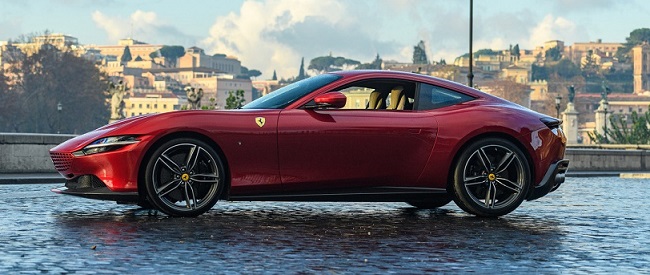

Coupe, 2 Doors, 4 Seats
620 Hp @ 5750-7500 rpm.
160.8 Hp/l
320 km/h 198.84 mph
3855 cm3
235.25 cu. in.
8, V-engine
Rear wheel drive,
4656 mm
183.31 in.
1974 mm
77.72 in.
1570 kg
3461.26 lbs.
| Brand | Ferrari |
|---|---|
| Model | Roma (Coupe) |
| Version | Roma |
| Engine version | 3.9 V8 (620 Hp) DCT |
| Year production start | 2020 |
| Vehicle type | Coupe |
| Horsepower RPM | 620 Hp @ 5750-7500 rpm. |
| Acceleration 0 - 100 kmh sec | 3.4 sec |
| Curb weight kg -lbs total |
1570 kg3461.26 lbs. |
| Overall length mm - inch |
4656 mm183.31 in. |
| Doors | 2 |
| Top Speed | 320 km/h 198.84 mph |
| Engine position and orientation | Front, Longitudinal |
|---|---|
| Cylinders | 8 |
| Position of cylinders | V-engine |
| Displacement (liters) |
3855 cm3235.25 cu. in. |
| Eng. horsepower RPM | 620 Hp @ 5750-7500 rpm. |
| Horsepower per litre | 160.8 Hp/l |
| Weight / horsepower kg/hp - hp/tons |
2.5 kg/Hp394.9 Hp/tonne |
| Weight / torque kg/Nm - Nm/tons | 2.1 kg/Nm, 484.1 Nm/tonne
2.1 kg/Nm484.1 Nm/tonne |
| Torque Nm RPM lb-ft RPM |
760 Nm @ 3000-5750 rpm.560.55 lb.-ft. @ 3000-5750 rpm. |
| Bore (mm in) |
86.5 mm3.41 in. |
| Stroke (mm in) |
82 mm3.23 in. |
| Compression ratio | 9.45 |
| Fuel delivery system | Direct injection |
| Fuel type | Petrol (Gasoline) |
| Engine aspiration | BiTurbo, Intercooler |
| Powertrain architecture | Internal Combustion engine |
| Engine location | Front, Longitudinal |
| Drive configuration | Rear wheel drive |
|---|
| Front brakes | Ventilated discs, 390 mm |
|---|---|
| Rear brakes | Ventilated discs, 360 mm |
| Anti-lock brake system | ABS (Anti-lock braking system) |
| Wheels size | Front wheel tires: 245/35 ZR20 |
|---|---|
| Wheels rims | Front wheel rims: 8J x 20 |
| Passengers seats | 4 |
|---|---|
| Trunk space min liter | cu. Ft. |
272 l9.61 cu. ft. |
| Trunk space max liter | cu. Ft. |
345 l12.18 cu. ft. |
| Overall length mm - inch |
4656 mm183.31 in. |
|---|---|
| Overall width mm -inch |
1974 mm77.72 in. |
| Overall height mm -inch |
1301 mm51.22 in. |
| Wheelbase mm - inch |
2670 mm105.12 in. |
| Track width front mm - inch |
1562 mm61.5 in. |
| Track width rear mm - inch |
1679 mm66.1 in. |
| Curb weight kg -lbs total |
1570 kg3461.26 lbs. |
|---|
| Combined fuel consumption (WLTP) | 11.2 l/100 km 21 US mpg |
|---|
8 CYLINDER V-Engine
https://www.thecarspec.net/components/engine/8-cylinders-v